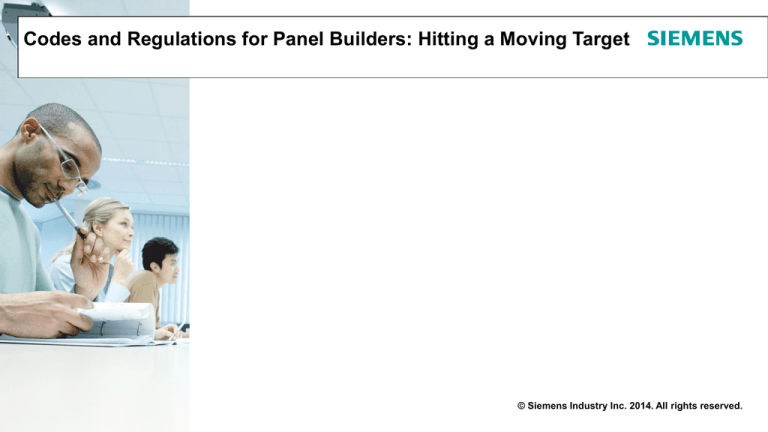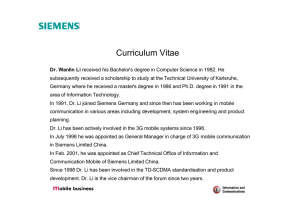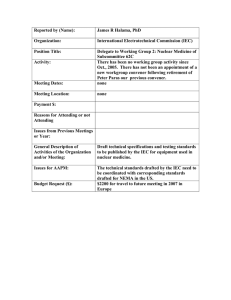
Codes and Regulations for Panel Builders: Hitting a Moving Target
© Siemens Industry Inc. 2014. All rights reserved.
DISCLAIMER/ TERMS OF USE:
THE INFORMATION PROVIDED HEREIN IS PROVIDED AS A GENERAL REFERENCE
REGARDING THE USE OF THE APPLICABLE PRODUCTS IN GENERIC APPLICATIONS. THIS
INFORMATION IS PROVIDED WITHOUT WARRANTY. IT IS YOUR RESPONSIBILITY TO ENSURE
THAT YOU ARE USING ALL MENTIONED PRODUCTS PROPERLY IN YOUR SPECIFIC
APPLICATION. ALTHOUGH THIS PRESENTATION STRIVES TO MAINTAIN ACCURATE AND
RELEVANT INFORMATION, THERE IS NO OFFICIAL GUARANTEE THAT THE INFORMATION
PROVIDED HEREIN IS ACCURATE. IF YOU USE THE INFORMATION PROVIDED HEREIN IN YOUR
SPECIFIC APPLICATION, PLEASE DOUBLE CHECK ITS APPLICABILITY AND BE ADVISED THAT
YOU ARE USING THIS INFORMATION AT YOUR OWN RISK. THE PURCHASER OF THE PRODUCT
MUST CONFIRM THE SUITABILITY OF THE PRODUCT FOR THE INTENDED USE, AND ASSUME
ALL RISK AND LIABILITY IN CONNECTION WITH THE USE.
Page 2
11/2014
Introduction, Basic differences
© Siemens Industry Inc. 2014. All rights reserved.
Industry Sector / I IA CE S V
Codes and Regulations for Panel Builders: Hitting a Moving Target
- Introduction to the webinar
- Basic differences between North America
and Europe
Why this webinar?
Webinar objectives
Basic differences between North America and Europe
© Siemens AG 2014. All rights reserved.
Why this webinar?
In an increasingly globalized market, it is important to understand the differences in standards
related to building “Industrial Control Panels” (ICP) for UL markets and “Low-voltage switchgear
and control gear assemblies” for IEC markets.
What is an Industrial Control Panel or Low-voltage switchgear and control gear assembly?
Which standards are important for control panel design
Address uncertainty with regard to the question: "Who holds the responsibility?"
Page 4
11/2014
Introduction, Basic differences
© Siemens Industry Inc. 2014. All rights reserved.
Industry Sector / I IA CE S V
Webinar objectives
Introduction to European Directives and standards
Refresher and update for the relevant North American standards (UL/NFPA)
To provide an understanding important European Directives and standards
To clarify the similarities and differences between relevant standards and their significance for
control panel design
Page 5
11/2014
Introduction, Basic differences
© Siemens Industry Inc. 2014. All rights reserved.
Industry Sector / I IA CE S V
Organizations
The global use of standards
IEC, e.g.: EN, VDE, BS, NF, GB
UL / NFPA / NEMA
UL / NFPA / NEMA / IEC
CSA / UL / NFPA / NEMA
Page 6
11/2014
Introduction, Basic differences
© Siemens Industry Inc. 2014. All rights reserved.
Industry Sector / I IA CE S V
What is an Industrial Control Panel (ICP)?
UL Definition:
Page 7
11/2014
Introduction, Basic differences
© Siemens Industry Inc. 2014. All rights reserved.
Industry Sector / I IA CE S V
What is an Industrial Control Panel (ICP)?
IEC Definition:
Low-voltage switchgear and controlgear assembly [e.g. industrial control
panel]
Assembly of one or several low-voltage switchgears and controlgears with
related equipment for control, measurement, reporting, protection, and regulation,
with all the internal electrical and mechanical connections and structural components
Page 8
11/2014
Introduction, Basic differences
© Siemens Industry Inc. 2014. All rights reserved.
Industry Sector / I IA CE S V
Basic differences between U.S. and CE Markets
Standards – Comparison between USA and IEC
UL / NEMA Standard
IEC Standard
Description
NFPA 70
IEC 60364-1
Use of electrical equipment
NFPA 79
IEC 60204-1
Installation of electrical equipment
UL508A
IEC 61439-1
Design standards for Industrial Control
Panels
UL 489 (CBs)
Design standards for individual components
UL 508 (Control components)
(UL uses separate standards for different
UL 98 (Safety switches)
IEC 60947
types of components. IEC standard 60947
UL 248 (Fuses)
has different sections for different types of
UL … (etc.)
components)
Page 9
11/2014
Introduction, Basic differences
© Siemens Industry Inc. 2014. All rights reserved.
Industry Sector / I IA CE S V
Basic differences between U.S. and CE Markets
Standards – Comparison between USA and IEC
IEC 60204-1
IEC 61439-1
IEC 60204-1
IEC 61439-1
IEC 60947
IEC 61008
Page 10
11/2014
Introduction, Basic differences
© Siemens Industry Inc. 2014. All rights reserved.
Industry Sector / I IA CE S V
Differences between Europe & North America
Europe
USA / North America
Responsibility of the equipment manufacturer
Responsibility of the operator/user
Responsibility of the operator/user
Protection targets and requirements are
defined by laws
Protection targets are defined by directives
Presumption of conformity with the application
of harmonized standards (ISO9000 et seqq.,
self-certification, self-responsibility)
Certification/listing of products
Verification by independent NRTL/AHJ
(Electrical Inspector) (third-party certification)
+ Operating approval
of AHJ
Page 11
11/2014
Introduction, Basic differences
© Siemens Industry Inc. 2014. All rights reserved.
Industry Sector / I IA CE S V
The importance of standards
In general, standards are:
Standards are not laws – yet they are followed willingly and strictly. When they are followed they
are similar to laws
Reflect rules / the state of technology and are considered a proven method in the respective
field of application
A support function used to achieve a minimum level of procedure (in different countries, etc.)
Fulfilling standards is not an achievement – it is the minimum expected
The highest protection objectives of standards are: the safety of people, livestock, and property
Page 12
11/2014
Introduction, Basic differences
© Siemens Industry Inc. 2014. All rights reserved.
Industry Sector / I IA CE S V
Similarities Between UL and IEC ICP Standards
Fulfilling standards is not an achievement – it is the minimum expected
Short Circuit Current Rating (SCCR) is required if power circuits are present. An SCCR is not
required if only control components (relays, pilot devices, etc.) are included in the ICP.
A Main Disconnect means is required.
ICPs for use in hazardous locations must meet additional standards (UL698A and IEC 60079)
Arc flash risks are mitigated upstream of the ICP.
Page 13
11/2014
Introduction, Basic differences
© Siemens Industry Inc. 2014. All rights reserved.
Industry Sector / I IA CE S V
Differences between Europe & North America
USA / North America
Europe
Primary standard UL 508A
Primary standard IEC 61439-1
600V maximum (NEC 409 allows 1000V, but UL
and available components do not support)
1000VAC or 1500VDC maximum
Main disconnecting means must be
interlocked with the door requiring an
intentional act with a tool to open. All
components that are not deenergized by the
main disconnect must be either touch safe or
barriered.
Interlocking of the main disconnect with the
enclosure is not required. Opening the
enclosure door does tool operated access
(bolt down cover), but not interlocking. All
components that are not deenergized by the
main disconnect must be either touch safe or
barriered.
+ Operating approval
of AHJ
Page 14
11/2014
Introduction, Basic differences
© Siemens Industry Inc. 2014. All rights reserved.
Industry Sector / I IA CE S V
Differences between Europe & North America
USA / North America
Europe
UL listed fuses, Class CC, R, J, L, etc. are
acceptable
IEC rated fuses must be used. UL listed fused
cannot be used in an IEC panel.
+ Operating approval
of AHJ
Page 15
11/2014
Introduction, Basic differences
© Siemens Industry Inc. 2014. All rights reserved.
Industry Sector / I IA CE S V
UL 508A Procedure for Establishing the SCCR
Determination of the short-circuit current rating (SCCR) acc. to NEC409.110 (4):
Step 1: necessary!
SCCR of the installed and UL-listed components
Step 2: necessary!
Establishment of the SCCR on the basis of standard values
(UL508A suppl. SB or UL-guide; chapter 5.8.4).
Step 3: Optional, very helpfull!
SCCR of tested industrial control equipment assemblies
(series rating = 2 circuit breakers in series or combination tests = motor branch circuits)
Step 4: Optional, not very helpfull!
Use of current limiting devices (transformers, fuses, circuit breakers)
Page 16
11/2014
Introduction, Basic differences
© Siemens Industry Inc. 2014. All rights reserved.
Industry Sector / I IA CE S V
UL 508A Procedure for Establishing the SCCR
Determination of the short-circuit current
rating (SCCR) acc. to NEC409.110 (4):
Step 1: necessary!
SCCR of the installed and UL-listed
components
SCCR of listed components can be found
on the device lable, manufacturer
supplied Certificate of Compliance (CoC),
or in UL508A Table SB4.1
Page 17
11/2014
Introduction, Basic differences
© Siemens Industry Inc. 2014. All rights reserved.
Industry Sector / I IA CE S V
Design verification – performance IEC 61439
Verification of short-circuit withstand strength
Verification of rated currents for short circuits via
Comparison with a tested reference construction (checklist or calculation)
Testing
Verification of the short-circuit withstand strength of circuits is not required for:
a) Switchgear and controlgear assemblies with a rated short-term withstand current Icw or a
conditional rated short-circuit current Icc with a root mean square value of 10 kA at the most;
b) Switchgear and controlgear assemblies or circuits of switchgear and controlgear assemblies,
protected by current-limiting devices, whose peak-let through current at the highest permissible
uninfluenced short-circuit current at the in-feed terminals of the switchgear and controlgear
assembly does not exceed 17 kA;
c) For auxiliary circuits: UN ≥ 110 V, PN ≤ 10 kVA and uk ≥ 4%
UN < 110 V, PN ≤ 1.6 kVA and uk ≥ 4%
Page 18
11/2014
Introduction, Basic differences
© Siemens Industry Inc. 2014. All rights reserved.
Industry Sector / I IA CE S V
Enclosure Environmental ratings, NEMA and IEC
Note that the NEMA Enclosure
Ratings and IEC Equivalent (IP)
ratings are approximations, not
direct 1:1 equivalents.
Page 19
11/2014
Introduction, Basic differences
© Siemens Industry Inc. 2014. All rights reserved.
Industry Sector / I IA CE S V
Additional Information Resources
Additional information and resources
regarding industrial control panel design
can be obtained by following these links:
www.usa.siemens.com/controlpaneldesign
or
http://www.industry.usa.siemens.com/autom
ation/us/en/industrial-controls/tools-andresources/Pages/IndustrialPanelDesignGui
de.aspx
Page 20
11/2014
Introduction, Basic differences
© Siemens Industry Inc. 2014. All rights reserved.
Industry Sector / I IA CE S V
Thank you!
Jeff Woolfolk
Siemens Industry, Inc.
5300 Triangle Parkway
Norcross, GA 30092
Email: jeffrey.woolfolk@siemens.com
Phone: (770) 625-5760
Cell: (404) 790-4474
Page 21
11/2014
Introduction, Basic differences
© Siemens Industry Inc. 2014. All rights reserved.
Industry Sector / I IA CE S V
Questions?
© Siemens Industry Inc. 2014. All rights reserved.



